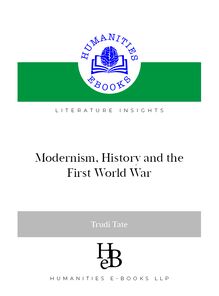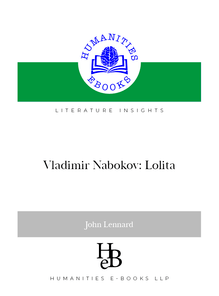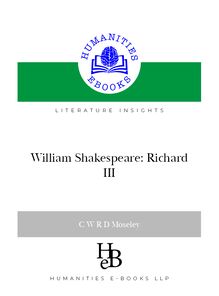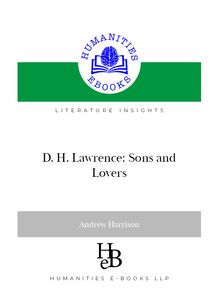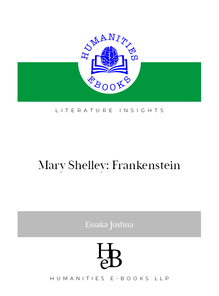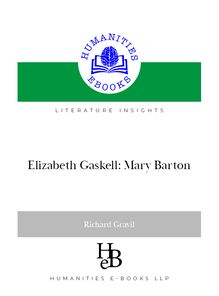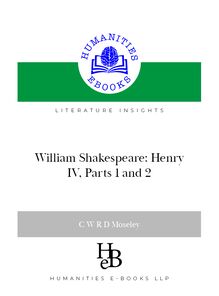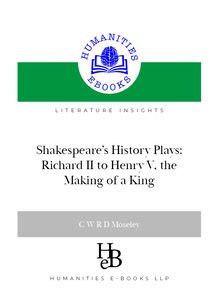-
 Univers
Univers
-
 Ebooks
Ebooks
-
 Livres audio
Livres audio
-
 Presse
Presse
-
 Podcasts
Podcasts
-
 BD
BD
-
 Documents
Documents
-
- Cours
- Révisions
- Ressources pédagogiques
- Sciences de l’éducation
- Manuels scolaires
- Langues
- Travaux de classe
- Annales de BEP
- Etudes supérieures
- Maternelle et primaire
- Fiches de lecture
- Orientation scolaire
- Méthodologie
- Corrigés de devoir
- Annales d’examens et concours
- Annales du bac
- Annales du brevet
- Rapports de stage
La lecture à portée de main
184 pages
English
Découvre YouScribe en t'inscrivant gratuitement
Je m'inscrisEnglish Renaissance Drama: A Very Short Introduction to Theatre and Theatres in Shakespeare's Time , livre ebook
Découvre YouScribe en t'inscrivant gratuitement
Je m'inscris
Obtenez un accès à la bibliothèque pour le consulter en ligne
En savoir plus
En savoir plus
184 pages
English
Obtenez un accès à la bibliothèque pour le consulter en ligne
En savoir plus
En savoir plus

Description
This book, also available in paperback from Troubador, introduces the conclusions of recent scholarship and research into theatrical conditions, conventions and concepts in the time of Shakespeare.
Sujets
Informations
| Publié par | Humanities eBooks |
| Date de parution | 11 janvier 2021 |
| Nombre de lectures | 0 |
| EAN13 | 9781847600202 |
| Langue | English |
| Poids de l'ouvrage | 2 Mo |
Informations légales : prix de location à la page 0,0350€. Cette information est donnée uniquement à titre indicatif conformément à la législation en vigueur.
Extrait
Running Head 1 English RenaissanceDrama C. W. R. D. Moseley
an Introduction to Theatre and Theatres in Shakespeare’s Time
PublicationData
© c. W. R. D. MOSeLey, 2007
the aUThOr hàS àSSerTed hIS rIGhT TO Be IdeNTIfIed àS The àUThOr Of ThIS WOrk IN àC-COrdàNCe wITh The cOpyrIGhT, DeSIGNS àNd PàTeNTS aCT 1988.
PUBLIShed IN 2007 ByHumanities-Ebooks.co.uk tIrrIL HàLL, tIrrIL, PeNrITh ca10 2JE
REaDinganDlistEningoPtions
*tO USe The NàvIGàTION TOOLS, The SeàrCh fàCILITy, àNd OTher feàTUreS Of The TOOL-Bàr, ThIS EBOOk ShOULd Be reàd IN defàULT vIew. *tO NàvIGàTe ThrOUGh The CONTeNTS USe The hyperLINked ‘bOOkmàrkS’ àT The LefT Of The SCreeN. *tO SeàrCh, expàNd The SeàrCh COLUmN àT The rIGhT Of The SCreeN Or CLICk ON The BINOCULàr SymBOL IN The TOOLBàr. *FOr eàSe Of reàdING, USe <ctRl+l> TO eNLàrGe The pàGe TO fULL SCreeN *uSe <ESC> TO reTUrN TO The fULL meNU. *HyperLINkS (exTerNàL àNd INTerNàL) àppeàr IN bLUe uNderLINed texT. tO reTUrN pLeàSe USe The ‘prevIOUS vIew’ BUTTON.
licEncEanDPERMissions
PUrChàSING ThIS BOOk LICeNSeS yOU TO reàd ThIS wOrk ON-SCreeN àNd TO prINT ONe COpy fOr yOUr OwN USe. cOpy àNd pàSTe fUNCTIONS àre dISàBLed. nO pàrT Of ThIS pUBLICàTION mày Be OTherwISe reprOdUCed Or TràNSmITTed Or dISTrIBUTed wIThOUT The prIOr wrITTeN permISSION Of BOTh The COpyrIGhT OwNer àNd The pUBLISher. MàkING Or dISTrIBUTING COpIeS Of ThIS BOOk CONSTITUTeS COpyrIGhT INfrINGemeNT àNd wOULd Be LIàBLe TO prOS-eCUTION. thàNk yOU fOr reSpeCTING The rIGhTS Of The àUThOr.
isbn 978-1-84760-020-2
ENGLISh ReNàISSàNCe DràmààN iNTrOdUCTION TO theàTre àNd theàTreS IN shàkeSpeàre’S tIme
c. W. R. D. MOSeLey
HEB☼HumanitiesEbooks, LLP
A Note on the Author
Dr Moseley is Fellow and Tutor of Hughes Hall, Cambridge, and Director of Stud-ies in English both for that College and also for St Edmund’s College. He lectures and teaches in Classics and in Mediaeval and Renaissance literature in the English Faculty of the University of Cambridge, and is the author of many books and articles, not all in his specialist îelds. For many years he was Programme Director of the Uni-versity of Cambridge International Summer Schools in Shakespeare and in English Literature, and is Director of the University of Cambridge Institute of Continuing Education’s Advanced Diploma in Shakespeare Studies, and University Moderator of its Diploma in Theatre and Theatre History. He has lectured frequently in the United States. He is a Fellow of the Society of Antiquaries of London, a Fellow of the Eng-lish Association, and is also a member of the Society for Nautical Research and a Fellow of the Royal Society of Arts. He has travelled widely in the Arctic, and is a member of the Arctic Club
Introduction
Shakespeare and his contemporaries were not writing ‘literature’. They were writing plays, and plays were a pretty lowstatus form of writing, hardly worth committing to print. True, by the year Shakespeare died his not uncritical friend, colleague and competitor, Ben Jonson, was trying to change all that. In 1616 Jonson dared to print hisThe Works of Ben Jonson– a title challenging comparison with theOperaof the poetic giants of the Latinpast – and did it in the smart, expensivefolioformat, the format usually reserved for works of high seriousness: and he got a good deal of unkind ribbing from literary men not only for daring to do all this, as a writer in the 1 workaday medium ofalso, especially, for including in that bookEnglish, but something as downmarket as his plays. For most of Shakespeare’s life the writer was only one, and not always the most important one, among many people who made a play: sometimes the writer was called simply a ‘play patcher’, someone who cobbled a play together for the actors out of odd old ends; sometimes there were 2 several authors cooperating in a script – a far more helpful word – and neither Shakespeare nor Jonson thought it beneath them, for substantial periods (perhaps most) of their lives, so to work. And they were working to earn a living in a world that owed nobody anything. Our attitudes to theatre, to writers, and to reading are unimaginably different to those of that time. It is imperative before we go any further that we try to recapture some of that vanished mindset. If we do not, we shall consistently misunderstand both what those players and writers were trying to do, and how their work might have been watched – as well as how it operated in its society. For it did so operate: nobody but a fool writes for posterity, and these men wrote to make a living – quite a good one, in many cases – out of the tastes and enthusiasms and concerns of their contemporaries. It will be as well to bear in mind the crucial importance of that
1 The development of English vocabulary, syntax and resourcefulness, in prose and verse, to the point where it would equal or surpass the Classical languages is a conscious and often openly stated aim of many writers. 2 Jonson, Chapman and Marston all wrote together on the comedyEastward Ho!, and you can hardly see the joins. Peele almost certainly wrote the first act ofTitus Andronicus – which is included in the canon of Shakespeare’s works.
English Renaissance Drama
7
audience, and to try to discover something of what the experience of going to the theatre in Shakespeare’s time was like. But before we go further, let me outline the aims and concerns of this book. Nearly all students come to the plays, and the literature, of the last third of the reign of Elizabeth – say from 1585–1603 – and from the reign of James I – say up to 1625 – through Shakespeare: often through one play. That is about the worst possible way to do it, though people do have a remarkable capacity of surviving, and even flourishing, afterwards. For Shakespeare’s work has over four centuries acquired overtones and values, and a cultural authority, which it never possessed in its time, and it makes a very poor lens through which to view the rest of the period’s writing. Moreover, Shakespeare is in many ways, simply because of what he did, fundamentally untypical of his period, even though he is most certainly a man of the late Renaissance in the peculiar form it took in England – and we do him a great disservice if we ever pretend otherwise. There is a vast gulf between ‘Shakespeare’, where the word denotes a cultural locus of ideas and values of great complexity, affecting notions of Englishness, of education, of morality, of art, of the very language we speak, and William, son of John Shakespeare, born probably in 1564 at 1 Stratford, where he died in 1616, a man variously referred to as an ‘upstart crow’, ‘our Roscius’, ‘sweet Mr Shakespeare’ and known as a poet, a writer of more or less successful plays, and a very shrewd buyer of real estate. If we could only come to Shakespeare through the reading of his contemporaries, not only would we recognise his genius, the nature of his originality, more clearly, but we would also recognise the excellence of those men whom he knew, with whom he competed, and drank, and did business. We would still read and enjoy them even if Shakespeare had never existed. The first job of this book, then, is to attempt to provide something of that context of the working life of a dramatist writing against time to earn a living. This will entail, necessarily, consideration of a number of factors: 1.Where English drama came from, so to speak – that must affect what an audience expects it is going to get; 2.The expectations and tastes, values and concerns of their audiences – audiences bought the theatrical experience, and if they did not, the company had no dinner; 1 It was the dying playwright Greene who referred jealously to Shakespeare the newcomer – without a university education, too! – as an ‘upstart crow, beautified with our feathers’. Roscius was a famous Roman actor.
English Renaissance Drama
8
3.The nature and resources of the physical spaces in which plays might be staged; 4.The way the companies worked, and the effects of such a group of people working together for a long time on how things could be written; 5.Concepts of character; 6.The different sorts of plays, and how they might be recognised and received. We also have to recognise the provisionality of our knowledge about the past, the unconscious myopia of our own mindset. Our statements and opinions, whosesoever they are (including those of people who write books), should always be followed by a sort of unspoken question mark. As T. S. Eliot remarked, in every statement we make about the past there is an unquantifiable amount of error, simply because we cannot unbe four centuries. This short book cannot replace, or remove the need for, serious committed study and exploration in the period. A vast amount of material is easily available, and among primary sources for our study of the period are not only the large numbers of plays in print, and many on line, but also the very usefulRecords of Early English Drama. Contemporary accounts of theatre and theatregoing are less common than one would wish, perhaps because so many people went that a visit was hardly worth remarking. Among the most interesting, though their witness is often annoyingly 1 2 3 oblique, are Thomas Dekker , Simon Forman , Henslowe’s Diary , Johannes De 4 5 6 Witt , Thomas Platter , Baron Waldstein . There are plenty of source books, like Tanya Pollard’s excellentShakespeare’s Theater(2004), anthologising contemporary
1 The Gull’s Hornbook(1609) describes behaviour in the theatres. Possibly it exaggerates for comic effect. 2 Dr Simon Forman attended productions of four of Shakespeare's plays. Extracts from his diary are available atshakespeare.about.com/b/a/197345.htm 3 Philip Henslowe, entrepreneur, moneylender, investor in playhouses, bearpits and brothels, and father-in-law of the great actor Edward Alleyn, who was famous for the skill with which he delivered the ‘mighty lines’ of Christopher Marlowe, kept an invaluable diary in the 1590s. It contains much important material about the plays that were performed, their takings, and the stock in trade of the companies. See edition by R. A. Foakes,Henslowe’s Diary, second edition, Cambridge University Press. 4 In 1596 a Dutch traveller and student, Johannes de Witt, saw a play at the Swan Theatre andsketchedthe inside of the Swan. 5 Thomas Platter was a Swiss traveller who came to London in 1599. there is an extract from his diary, which gives a pungent whiff of London life athttp://www.evergreen.loyola.edu/~ cmitchell/platter.htm.6 Waldstein, a Czech, come to London in 1600. His diary has been translated by G. W. Groos (London 1982)
English Renaissance Drama
9
writing about theatre – in that case, mainly negative and theoretical. And finally there are the Cambridge Companions to English Renaissance Drama and to Shakespeare. Finally, a warning. I am deliberately stressing the competitive, topical co operative context, and in which the plays were created because too often it is simply ignored. It is actually a lot of fun to think in this way. But you could lose sight of the uncomfortable fact that a lot of Elizabethan plays are very fine works of art, and stand reading and rereading as does the very best poetry. They sometimes have a structural coherence and patterning with seems to belie the idea of their having many makers. In fact it does not, anymore than do the coherence of a cathedral, where we know hundreds of hands worked, or many voices and instruments coming together in musical symphony. Lukas Erne (Shakespeare as Literary Dramatist, Cambridge, 2003) maintains strongly that Shakespeare (and by implication the company of which he was a sharer) intended the plays for readers as well as audiences. (One might note in passing that to read a play in a printed text was itself a relatively new thing, which raises all sorts of questions of its own, in Shakespeare’s last years.) Ben Jonson certainly seems to have had his eye on that option. But here, as all too rarely, one can have one’s cake and eat it, for the intensely cooperative creation of a performance neither excludes the single reader later, nor does the text s/he reads deny the multitude of cooperative interpretations that may later be made of it. Furthermore, a ‘play patcher’ of genius, as we may, perhaps, assume Shakespeare for example to have been, may write very well indeed even when under the intense pressure and constraints of working in that theatrical environment for that discriminating and unforgiving market. The plays can be judged as art too: and perhaps we must allow far more for the idea of ‘Genius’ – it was far more difficult writing in the conditions I have outlined than in a tidy study where you can invent your own worlds, and then, only then, find someone to body them forth on the stage. The more we think about the constraints of the context, the higher we shall find ourselves rating those who worked and wrote in it. The time we shall concentrate on is one of the most uncomfortable in English history. The period of the growth and high noon of English Renaissance drama is from, say, from 1576 to 1642. In 1576 the entrepreneur Burbage built The Theatre, the first purpose built permanent building in England designed for the playing of a 1 plays if we discount John Brayne’s Red Bull of 1567, which was simply a modified 1Brayne was Burbage’s father in law. The Red Bull was outside the jurisdiction of the City magistrates in Stepney.
English Renaissance Drama
10
inn court yard. In 1642 Parliament imposed what it said would be a temporary ban on the public theatres throughout the land – and put the companies who depended on them out of work. Within that period the years 1585–1615 – roughly the years in which we have knowledge of Shakespeare’s theatrical life, and of Ben Jonson’s most innovative drama – may be seen as a high point. Certainly, the overwhelmingly majority of Renaissance plays a cultured, even fairly specialist, English speaker today would know would come from between those narrower dates. This period coincides with one of the tensest, most worried and unhappy periods of English life, from what has been called theNasty NinetiesPatrick Collinson and Katherine (by Duncan Jones among others) to the first rumblings of that clash between Parliament and Crown which would culminate in 1642 in the kinstrife of the Civil War. It was period of war. England was at war with Spain, and feared invasion several times – the panic caused by rumours of the arrival of the third Armada (see chronology below) in 1599 had everyone ablebodied under arms when they ought 1 to have been getting in the sparse harvest. The Privy Council nearly panicked itself into sinking block ships in the Thames to stop an invading force. England was at war in Ireland, desperately trying to contain the serious threat to her control posed by the very able O’Neill, earl of Tyrone. Civil War was a real fear, not least because the Queen had no clear heir, and refused to let the matter be discussed. Moreover, Pope Pius V in the BullRegnans in excelsis1570 had delegitimated Elizabeth and of released all her Catholic subjects from their allegiance to her in what must surely be one of the most politically inept pronouncements ever to come from Rome. Overnight, this turned the up to 40% of her subjects who were secretly or openly Catholic into potential traitors. Her cousin Mary of Scotland, her eventual successor’s mother, had been the focus of Catholic plots, real or imaginary, and had had to be executed in 1587. There were seriously advanced claims for the restoration of a Plantagenet heir, since the Tudor title to the throne was very dicey: that heir was, by descent, the Infanta of Spain, the Archduchess Isabella. As Francis Bacon, a rising star in her later years, and to be James’s Lord Chancellor, put it, in one of those books which one is grateful he never finished: [many said] after Queen Elizabeth's decease there must follow in England nothing but confusions, interreigns, and perturbations of estate, likely far to exceed the ancient calamities of the civil wars between the houses of Lancaster
1 The close circle of just about a dozen advisers and ministers around the monarch, who with the Prince were the supreme executive (as opposed to leglislative) authority.
English Renaissance Drama
11
and York, by how much more the dissensions were like to be more mortal and bloody when foreign competition should be added to domestical, and divisions for religion to matter of title to the crown. (As it happens, James’ succession was beautifully handled, and he was welcomed to London with much rejoicing: the Londoners had lit bonfires in the streets when news of the old unpopular queen’s death broke, but within a few years James and his Scottish hangerson were nearly as unpopular as she had been.) Command of the war in Ireland had been fatal to Elizabeth’s last favourite, the glamorous but hot headed Earl ofEssex, whom many would have like to see succeed her – he had royal blood, indeed. But his abortive rebellion led only to his ignominious trial – where Bacon, once his protégé, was prosecutor – and execution. The Irish war had drained the treasury, and the settlement of it by Mountjoy, burning and starving the Irish into surrendering and their leaders into exile, horrified even many who applied that settlement. But James, wiser than many in his Parliaments would have had him be, made peace with Spain in 1606, and kept his realms out of a European war, to be sure: but that looks more secure in hindsight than it did at the time. This was, too, a period of poor harvests, food riots, inflation, recurrent plague – and the aftermath of a revolution in the patterns of worship and devotion which had affected and still affected every single person in the land, when loyalties and affections and duties might be agonisingly split. It was period of religious strife and friction, and just over the water, in France, many had seen in the Wars of Religion an awful foretaste of what they feared might happen between Catholic and Protestant in a very divided England. Those wars were an anticipation of the terrible Europewide conflict of the Thirty Years’ War which erupted in 1618. Nobody knew what was coming, and as always most were walking backwards into the future, regretting the time past and fearing that to come. But all guessed that, even if the real possibility of civil war might be avoided (which in the end it was not), what was to come was not only still unsure, but might also be pretty nasty. Tennyson’s ‘spacious time of great Elizabeth’, the myth of that happy sunlit merrie England, is just that: myth. But, at the same time, this was is a period of great innovation and some hope for the future, and such contradictions and complications are evident in, mirrored by, the plays and the issues they raise in the oblique but penetrating way that art does. When you have something as popular, in all senses, as the drama of the period I shall call, for convenience, ‘Jacobethan’, it must have engaged with contemporary issues and concerns, and be in a profound sense ‘political’ – to do with the polity
-
 Univers
Univers
-
 Ebooks
Ebooks
-
 Livres audio
Livres audio
-
 Presse
Presse
-
 Podcasts
Podcasts
-
 BD
BD
-
 Documents
Documents
-
Jeunesse
-
Littérature
-
Ressources professionnelles
-
Santé et bien-être
-
Savoirs
-
Education
-
Loisirs et hobbies
-
Art, musique et cinéma
-
Actualité et débat de société
-
Jeunesse
-
Littérature
-
Ressources professionnelles
-
Santé et bien-être
-
Savoirs
-
Education
-
Loisirs et hobbies
-
Art, musique et cinéma
-
Actualité et débat de société
-
Actualités
-
Lifestyle
-
Presse jeunesse
-
Presse professionnelle
-
Pratique
-
Presse sportive
-
Presse internationale
-
Culture & Médias
-
Action et Aventures
-
Science-fiction et Fantasy
-
Société
-
Jeunesse
-
Littérature
-
Ressources professionnelles
-
Santé et bien-être
-
Savoirs
-
Education
-
Loisirs et hobbies
-
Art, musique et cinéma
-
Actualité et débat de société
- Cours
- Révisions
- Ressources pédagogiques
- Sciences de l’éducation
- Manuels scolaires
- Langues
- Travaux de classe
- Annales de BEP
- Etudes supérieures
- Maternelle et primaire
- Fiches de lecture
- Orientation scolaire
- Méthodologie
- Corrigés de devoir
- Annales d’examens et concours
- Annales du bac
- Annales du brevet
- Rapports de stage
Signaler un problème
YouScribe
Le catalogue
Le service
© 2010-2024 YouScribe
